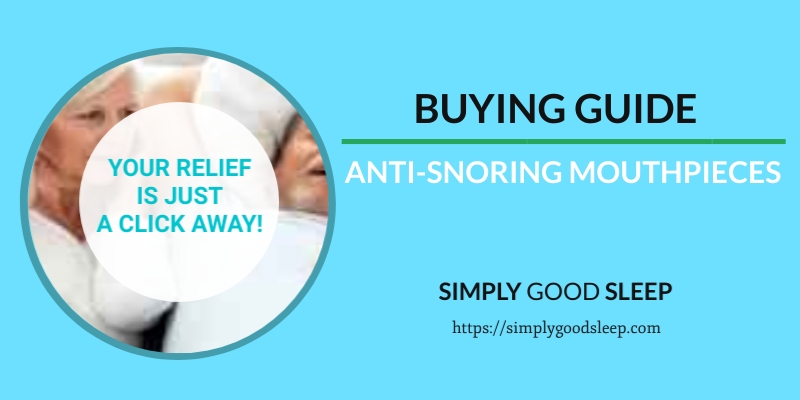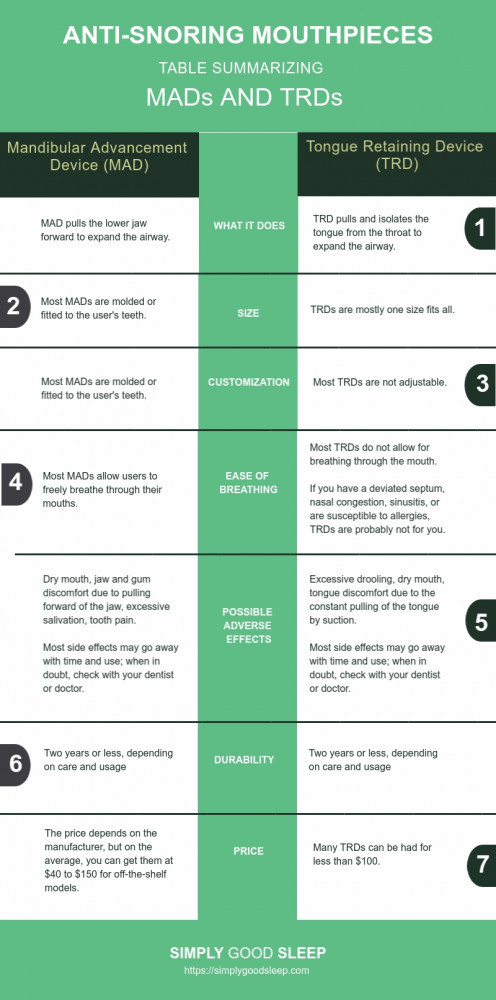
Millions of people suffer from snoring every night. But with anti-snoring mouthguards, you can definitely sleep better at night, which is very important for sound health. This buying guide will highlight key information about the two main types of anti-snoring mouthpieces — Mandibular Advancement Devices (MAD) and Tongue Retaining Devices (TRD) — that you need to decide which anti-snoring mouthpiece is right for you.
If you make a purchase through our affiliate links on this page, we may earn a small referral fee at no cost to you. Details here.
Reasons Why People Snore
Snoring is the direct result of air getting restricted in your air passage due to throat and neck muscles relaxing, and creating vibrations. Although many healthy adult men and women are habitual snorers, a lot of other physical conditions also contribute to snoring.
The first and most common reason behind snoring is being overweight. More weight adds more soft tissue inside our throat, restricting the smooth passage of air.
Sleep apnea is another very common reason behind snoring. It’s a medical condition where the airway gets completely blocked during sleep.
Not to mention, as we age, our muscles get more relaxed. So, it’s pretty common among older people to snore at night.
Other reasons include congestion inside the nose, deformation of the nose, pregnancy, alcohol consumption, and any other activity or condition that might restrict the flow of air.
For more information about snoring, please read our blog article on ‘Why people snore – and what can you do about it?‘
What is an Anti-Snore Mouthpiece?
The anti-snore mouthpiece is really a take-off from the mouthguards used in boxing and other sports where the lower teeth needs extra support to protect the jaw from dislocating itself after receiving a blow.
This simple anti-snoring device, as mentioned earlier, avoids the lower teeth and jaw from falling back and reducing the airspace in the throat.
As there is now more space for the air, there is much less danger of soft tissues colliding and vibrating to produce snoring. The result is a considerable noise reduction if not a complete cure to your snoring.
Anti-snoring dental mouthpieces are becoming the first-line option for the treatment of simple snoring and mild to moderate sleep apnea.
These dental devices are becoming more popular because they are economical, effective, and easy to use.
Types of Anti-snoring Mouthpieces
Anti-snoring mouthpieces work by keeping the airway free while you sleep. As we already know that snoring occurs due to the restriction of air, keeping the airway free will result in better sleep at night.
There are two main types of anti-snoring mouthpieces:
- Mandibular Advancement Devices (MAD)
- Tongue Retaining Devices (TRD)
Mandibular Advancement Devices
The mandible refers to your lower jaw. When you sleep, the lower jaw slides a little bit backward. It’s pretty normal but it might lead to snoring for a lot of people. This problem can be eliminated with help from a Mandibular Advancement Device.
The MAD is extremely popular with oral appliance users. A MAD lessens any restrictions in air flow by moving the lower jaw forward, which also keeps the tongue forward and away from the back of your throat.
MAD’ѕ are molded to a patient’s teeth which allows the upper jaw to remain in a fixed position while the lower jaw is pushed forward.
MADs come in three varieties:
- “Boil and Bite”, an over-the-counter option
- Semi-custom devices, which are made from a mold of the teeth
- Fully-custom MAD made by a dentist or a sleep specialist.
If MADs require fitting, it may mean visiting a professional, depending on the the type of mouthpiece you get.
Tongue Retaining Devices
TRDs or tongue retaining devices are simpler than MADs. They don’t stabilize the entire jaw. They are intended to keep the tongue in place, in a forward position, when you go to sleep. These devices help expand the space between your back of the throat and the tongue so that the tongue doesn’t accidentally restrict air.
They’re more of a universal device. There’s no need for molding or shaping. The tongue sits in an opening of the device and is held by suction.
Advantages of Anti-snoring Mouthpieces
These simple yet amazing devices come with a lot of advantages for people who snore at night:
- They stabilize the jaw and results in a better sleep
- Doesn’t let the tongue block the back of the throat
- Helps breath easily at night which is mandatory for good sleep
- Don’t have to worry about changing sleeping positions – for example, sleeping on your side if you’re a back sleeper
- Very affordable and easy to clean
- For frequent travelers, an anti-snoring mouthpiece is travel-friendly! In its (usually-provided) hard-shell case, it is easy to pack in one’s carry-on.
- Reduces your snoring and improves the quality of sleep that you (and your partner) get at night.
Considerations
Things to consider when using an anti-snoring mouthpiece:
- The anti-snoring mouthpiece may cause soreness or stiffness of the lower jaw, dry mouth, excessive salivation, dry mouth, and mouth ulcers.
- They may reduce snoring but will not address other symptoms of sleep apnea.
- They require change anywhere from six months to two years.
- Thorough routine cleaning of the anti-snoring mouthpiece is essential for healthy oral health.
- There may be an adjustment period – anywhere from a few days to weeks – getting used to the new device. After all, there is a foreign object in your mouth, so you are going to notice it. With time, however, you will get use to it and may not even notice it at all.
- Anti-snoring devices are not advised in people with gum disease, oral infections, loose or sore teeth, crowns, dentures, braces, and dental implants. When in doubt, consult your dentist.
- If you have any medical conditions, such as sleep apnea, please see your doctor to discuss snoring solutions.
Examples of (MAD) Anti-Snoring Mouthpieces
ZQuiet
- made from a soft medical-grade material that is BPA and latex free
- comes ready to wear in two different sizes so you may choose the one that fits and works better for you
- features a patented ‘living hinge’ technology, allowing for a more natural jaw movement, so that you can breathe, talk, and drink fluids easily while wearing the mouthpiece
- each mouthpiece has a hole in the front to permit breathing through your mouth
- ready to use; no boil-and-bite-fitting, although may require some trimming for better comfort
- produced by a company with a BBB (Better Business Bureau) A+ rating
- backed by a generous 60-nights money back guarantee
Click here to visit the ZQuiet website.
SnoreMeds
- uses boil-and-bite method that helps you mold the device to your teeth.
- made from FDA-approved materials that are BPA and latex free
- has two air holes which allow people who breathe through their mouth to use the device
- available in two different sizes, according to the size of your mouth
- has been around for ten years, which says a lot about its ability to meet the needs of snorers
- device comes with a spatula that can be used to ease the boil-and-bite process, as well as to clean the mouthpiece.
- backed by a 45-days money back guarantee
Click here to be visit the SnoreMeds website.
Example of (TRD) Anti-Snoring Mouthpieces
Good Morning Snore Solution
- a tongue restraining device that draws the tongue forward so that it does not block the airway
- produced by MPowrx, a company with a BBB (Better Business Bureau) A+ rating
- cleared by the Health Canada, FDA, Australian Register of Therapeutic Products, and European Economic Area.
- performed well in a clinical study demonstrating its effectiveness in reducing snoring
- BPA and BHA free
- does not require any special fitting
- can be used by people with dentures
- backed by a 30-nights money back guarantee
Click here to visit the Good Morning Snore Solution website.
Key Considerations in Buying an Anti-Snore Mouthpiece
Below are some factors to keep in mind when shopping for an anti-snoring mouthpiece:
Which One is Better? MAD or a TRD?
The choice comes down to personal preference. Both types of devices have their pros and cons.
Adjusted Fit
MADs can often be adjusted while TRDs are normally not adjustable. MAD is molded or fitted to the user’s teeth for a more custom-fit. TRD comes in a one-size-fits-all. TRDs fit almost everyone.
Comfort Feel
Comfort is personal and subjective and is affected by our preferences.
Specific Needs
-
Teeth-clenching or grinding during sleep
You’ll go MAD about this! MAD mouthpieces may help people with teeth-grinding or bruxism. TRD mouthpieces do not help with teeth-grinding during sleep.
-
Mouth-breathers during sleep
MAD mouthpieces enable allow users to breathe through their mouth. Most TRDs do not allow for breathing through the mouth.
-
Dentures
If you wear dentures, consider TRDs. TRDs can be used with dentures; MADs are not compatible with dentures.
-
Snoring due to sleep apnea
Anti-snoring mouthpieces may help reduce snoring, but do not address other signs and symptoms – such as loss of breath during the night – due to sleep apnea. You may need to consult a doctor for a more effective therapy for sleep apnea, such as CPAP.
Price
Your budget will dictate what kind of options are available to you. Many anti-snoring mouthpieces can be had for less than $100, but custom devices may cost much more.
For MADs, costs range from around $40 for the off-the-shelf models to almost $2000 for a top custom-fitted solution.
TRDѕ are usually less costly than MADs.
Trial period
MAD or TRD mouthpieces may offer a trial period – anywhere from 30 to 90 nights – allowing purchasers to return the product within the trial period if they are not happy with it.
Prescription status
Check prescription requirements for anti-snoring mouthpieces with your doctor or with the company website.
Certification
Check the product’s packaging and/or consult the company website.
Cleaning
Regardless of the mouthpiece you use, it is important to always keep it clean. Check the manufacturer’s instructions for cleaning.

Final Words
Anti-snoring mouthpieces could be your new best friend if you are looking for snoring solutions. They can ensure better sleep at night by keeping your breathing normal and healthy. Your Relief is Just A Click Away! Get yours today!




2 Responses
Hi there, I found your blog through google search. I really enjoyed your post about anti-snoring mouthpieces. I have bookmarked it for my future reference.
Thank you! We’re glad you find our ‘Buying Guide: Anti-Snoring Mouthpieces’ article helpful. Please feel free to reach out to us if you have any questions about anti-snoring mouthpieces or about sleep!